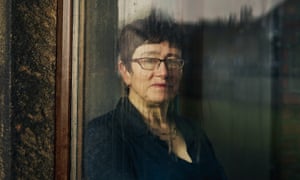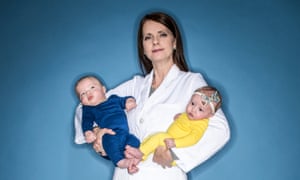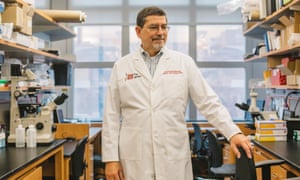The dermatologist with skin problems
Bav Shergill: As a teenager I was terribly embarrassed about my skin – I had really bad acne from the age of 15. It took me until I went to medical school to find the courage and confidence to change my GP and get a hospital referral.
Now, when i’m treating patients with acne I can reassure them by drawing on my own experience. I can say: “I was on this drug, too, and my head didn’t fall off.”
This connection between my own experience and relating to patients increased in my late 30s when I discovered I had rosacea. This causes severe redness and inflammation and can develop into acne-like spots, accompanied by a stinging, burning sensation.
Rosacea breakouts can be triggered by a number of things, including caffeine, alcohol and stress – in my case, I was preparing to go on TV while working full-time and trying to look after a poorly, heavily pregnant wife and small child at home when my face flared up. I’d treated rosacea before, so I knew what it was, but mine was the worst case I’d ever seen.
A nurse I worked with said: “It’s OK, there’s a whole range of products for rosacea and acne-type skin. We can cover this up.” I would never have considered make-up, but watching the programme later, I couldn’t see a blemish.
So that’s a tip I was then able to pass on to patients. If they were worried about putting cream on their painful skin, I was able to reliably tell them that the discomfort would pass and I was living proof the medication worked. I know only too well how difficult it can be to face the world during an outbreak, so I don’t brush aside that aspect of it at all. I’m aware how much it can impact on someone.
I have also learned that it’s possible to compromise – with rosacea you’re advised to avoid red wine and coffee, both of which I enjoy. I can help patients make an informed decision. I’ll say: “Look, life’s short and if you want a cup of coffee, go ahead. Your skin may look worse tomorrow, but it’ll get better.” It becomes more of a collaborative situation, where we share experiences and I do think the fact I’m candid about it helps patients relax.
I know very well what it’s like to wait three months for an appointment and then have 10 minutes with the doctor and think: “That was a lot of build-up for not a lot of time. Have they really understood me?”
I’m not saying every doctor has to suffer with the disease they specialise in to excel in their field, but I do think it increases your understanding and empathy levels.
Dr Bav Shergill is a consultant dermatologist at Queen Victoria Hospital, East Grinstead
The psychiatrist who suffers from depression

Linda Gask: In psychiatry there’s an emphasis on “strength”. I can only think of one other senior psychiatrist who’s come out and said he’s had depression. There are still people within the profession who I am sure would view my problems as my own personal weakness.
In my family everyone experienced mental health problems of one kind or another. It wasn’t the easiest environment to grow up in. By the time I went to university to study medicine I was often overwhelmed by anxiety.
Following a particularly debilitating period of depression, I got in touch with the psychiatrist who had treated me and asked if he thought it was something I could do. It was the area of medical training I felt most at home in. I felt my ability to understand how people felt was helpful. To my delight, he agreed.
I’ve experienced three or four prolonged episodes of depression and I’ve taken antidepressants for more than 20 years. I’m aware some of my colleagues would take issue with that – some think medication doesn’t work or can even be dangerous. But I know how helpful it has been for me.
I don’t think being a psychiatrist automatically makes you aware of your own processes. It’s not a matter of insight, of being able to heal yourself. There’s never just one simple solution and sometimes you need someone to talk to – someone who won’t try to offer reassurance, as a friend might, by reminding us of everything that’s good in our lives.
My own experience of therapy has taught me how important it is to engage your patient. You can’t just sit back and think: “Have I asked the right questions here? What’s the diagnosis and what’s the treatment?” as if working through a recipe. Instead, I’ve learned to think: “This is a person like me, perhaps with similar kinds of problems to the ones I’ve had. How can I reach out to them and help?”
Patients have occasionally picked up on the kind of questions I’ve asked during a consultation, or when I’ve given an example that particularly resonated with them. I’m well aware of how difficult it can be just to make it to your appointment in the first place – how some days, even getting out of bed can become impossible. I’ve had patients say: “I think you might have experienced this as well? Have you?” In those instances, I have to step back and say: “Well, yes, but this is your time so we won’t talk about me, but I do understand quite a lot how you are feeling.” It’s possible to retain a boundary while still offering a glimpse of your humanity and, though that approach isn’t encouraged, some patients told me they really appreciated it.
I’ve never felt any need to hide the fact I was seeking help myself, either. I’ve been treated by colleagues and told I could wait in private, away from the waiting room, as if I’d be worried about the risk of being spotted by a patient or colleague who recognised me. But I’ve always made a point of sitting with everyone else. We really are not being honest with ourselves if we say that we’re against stigma, but we won’t sit and wait with those we treat. I’ve spent years telling people that mental health issues are nothing to be ashamed of, so why would I do otherwise?
Professor Linda Gask’s The Other Side of Silence: a Psychiatrist’s Memoir of Depression, is published by Vie Books at £9.99. To order a copy for £8.49, go to bookshop.theguardian.com
The fertility expert who couldn’t conceive

Shannon Clark:The first time I saw a baby being born, the course of my life changed. That first delivery took place in an operating room, a very sterile environment, and we all wore masks and gowns. I was completely overwhelmed – no one could see, but I was crying.
I decided to specialise in high-risk obstetrics, and for a long time I thought I’d be OK if I never experienced motherhood myself. My goal in life was to be the best doctor I could be.
That altered when I met my future husband, René. Suddenly, the desire to have my own children became strong. We married within a year and a half and started to try for a baby – I was 39. Obviously, I knew all about the biological clock, but somehow felt it didn’t apply to me. I was healthy, I didn’t drink or smoke, I worked out and didn’t have any medical problems. Everything I ever wanted to achieve I was able to with ease. I guess I felt becoming a mother was no exception. But I was wrong.
I became pregnant within a few months of marrying, but miscarried. The next thing I knew, I was 40 and panic set in. We were told that our best option for conceiving was IVF.
Over the next 18 months we went through five cycles. Meanwhile, I was still working and delivering babies for other women. It was hard not to think: “Why not me?” But I couldn’t let it overwhelm me.
Those IVF cycles produced only one embryo that was chromosomally normal. It was transferred, but failed, so we decided to try donor eggs. The first two donor egg embryos failed as well, but we tried again in March of last year. After two years of infertility treatments, I became pregnant with twins.
As a physician, I was all too aware that twin pregnancies are high risk. But I knew I couldn’t have been in better hands. I was very lucky to make it to 31 weeks when I went into labour and had my babies by emergency C-section.
It all happened so quickly. I didn’t get to see my son, Remy, and daughter, Sydney, until nearly 24 hours after they were born. Although I knew what to expect, I was still startled at how small they were.
Now they’re both thriving, healthy and five months old, and I’ve just recently started back at work. Before the twins, I’d deliver babies and hand them to the paediatrician straight away. Now I want to hold them a little longer, spend more time at the mother’s bedside.
When you’re a physician and you’ve gone through something your patients are going through, you have to read that patient to see if it’s appropriate to say: “Well, I went through it too.” But at least I can understand a little more and I’ll choose my words more carefully, I’ll take more time with her. There are little things I can do to try and make it better.
Some parts of my job are a bit harder now. After maternity leave, the first time I delivered a baby that didn’t survive I just broke down. Having been through infertility and pregnancy loss myself, it’s much harder to see another woman experience it.
That’s one of the biggest things I’ve learned. A pregnancy loss before there’s even a heartbeat can be just as devastating as later on. I need to give all women the time they need to grieve and heal. I understand that better now.
Dr Shannon M Clark is a maternal-fetal medicine specialist at UTMB-Galveston, Texas, and founder of BabiesAfter35.com
The oncologist who survived cancer

David Carbone: One of the things that attracted me to lung cancer was the intensity of the doctor- patient relationship. Almost all my patients come to me with a diagnosis in advanced lung cancer. They’re hearing this totally new vocabulary, meeting a new set of people in whom they are trusting their lives.
Seventeen years ago, I was an associate professor in my second academic job and 44 years old. I was shaving before going into a meeting and noticed my neck veins were sticking out. I knew I didn’t have a cardiac condition, so the first thing that came to mind was superior vena cava syndrome, caused by a mass in the chest. When I got home from the meeting I ordered a chest x-ray, which indeed revealed a mass in the centre of my chest, and a lung mass as well. A CT scan backed this up and I suspected I had stage III lung cancer, because I’d seen patients present exactly the same way.
To be an oncology physician in that situation is both easier and harder than being a patient without medical training. Easier because I knew the physicians I could trust with my life; but also harder because I’ve seen how ugly cancer can be and how horribly people die.
My father was an oncologist, too, and I phoned him and said: “Dad, it’s c… It’s c…” I couldn’t even say the word. It took me a few tries to get it out. It was the start of a rough few years. My wife ended up leaving me. I’m now happily remarried, but it showed me that you can never predict how people will react.
Once part of my left lung had been removed and the mass in my chest biopsied, it turned out I had a large cell lymphoma, rather than lung cancer. On the face of it, that was good news, but the first medical articles I read still only gave me a 17% chance of five years’ survival. I was afraid, largely because I worried about what would happen to my children. Age from six to 12, each of them had a different level of understanding. The eldest was aware that he might lose his dad. The youngest ones saw my hair falling out during chemotherapy and became frightened I had something contagious they were going to catch.
That really brought home to me the importance of family and friends in the cancer patient’s experience. Some patients have family members around them every single time they see me, others always come alone. They catch the bus in to get their therapy and they take it back home, and it’s pretty sad to see that – even 20 or 30-year-old people sometimes suffering alone with no support system.
I always dealt empathetically with my patients, but until I lived their experience, I don’t think I fully understood it. I survived my cancer, but I still lost part of my lung, had multiple rounds of multi-agent chemotherapy and radiation, thoracic surgery and inadequate pain control – I’ve experienced how bad the side-effects of therapy can feel. I actually enjoy taking these desperate patients and trying to make them comfortable with me as a partner in fighting this disease. I give them my phone number and often see them every two or three weeks until they die. As I said, it’s an intense relationship, but a meaningful one and often a rewarding one, too.
Dr David P Carbone, MD, PhD is a director at the James Thoracic Center, James Cancer Hospital and Solove Research Institute, Ohio State University
Heal thyself: meet the doctors living with the conditions they treat
Hiç yorum yok:
Yorum Gönder